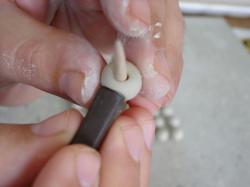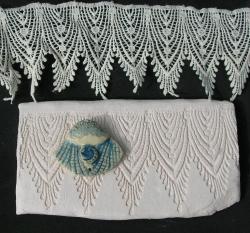Decoration - Wet Clay
The decoration of clay is a broad subject as is the art of ceramic itself. Decoration of ceramic wares can and often does beg,in at the earliest stages of production when the clay is still wet.
After the basic forming or as a part of the forming wet clay decoration can be achieved in a variety of ways. For example:
Stamping, Carving, Mishima, Sgraffito, Slip Stamping, Slip Layering, Slip Trailing
Stamping is a frequently used method of decorating wet clay. A variety of tools can be used to accomplish this. After the basic forming or as a part of the forming wet clay decoration can be achieved in a variety of ways. For example:
Stamping, Carving, Mishima, Sgraffito, Slip Stamping, Slip Layering, Slip Trailing
 As can be seen in this photo from the tutorial by Vladislav Ivanov of Golem Design Studio, stamps can be small hand made clay stamps. This technique allows for the replication of hand carved designs onto multiple beads much more easily and quickly than would be possible by hand carving each bead. The resulting beads are more uniform and because they can be accomplished more quickly they can be made more economically.
As can be seen in this photo from the tutorial by Vladislav Ivanov of Golem Design Studio, stamps can be small hand made clay stamps. This technique allows for the replication of hand carved designs onto multiple beads much more easily and quickly than would be possible by hand carving each bead. The resulting beads are more uniform and because they can be accomplished more quickly they can be made more economically. The photo on the left from the tutorial by Sheila LaPointe is of a mold made by 'stamping' lace into clay. The mold is then used as a sort of reverse stamp. Where all or part of the design can be used in an individual piece. This mold can be used for impressing small pieces or a larger slab which can then be cut to create individual pieces. This illustrates how the talent of the artist in the placement of the decoration can transform a simple design into a complex and interesting piece of art.
The photo on the left from the tutorial by Sheila LaPointe is of a mold made by 'stamping' lace into clay. The mold is then used as a sort of reverse stamp. Where all or part of the design can be used in an individual piece. This mold can be used for impressing small pieces or a larger slab which can then be cut to create individual pieces. This illustrates how the talent of the artist in the placement of the decoration can transform a simple design into a complex and interesting piece of art.
Carving: We can carve the clay as it begins to dry out. Complex designs can be carved into clay using a variety of tools. This is a relatively easy method of decoration. The clay is not difficult to carve and it doesn't have a grain like wood does to complicate things. Care must be taken to not allow the object to dry out too much while one is carving it or it will become more brittle and easily broken, however. More talent is required for the carving than stamping because you are creating the design by your own hand not just transferring it into the clay surface. Some aids to this would include tracing a pattern onto the clay with a pencil or stylus but the depth and contours of the design are created by hand using the tools. This method does not lend itself to exact copies as it is nearly impossible even with a traced design to get the carving done exactly the same. It also takes considerably longer and is for that reason also not really well suited for multiples. It does provide for much more variation in the depth, contour, and texture of the design and also can result in sharper edges and pierced areas. Carving can be combined with stamping or molding to modify and enhance a stamped or molded design as well. The photo shown here is of a piece that was hand carved and then washed with color to enhance the contours. The design for this piece was transferred onto the wet clay from a pencil drawing. You can see examples of where the carving has resulted in pierced areas in the carved design.
Slip Decoration: Slip or liquid clay can be used in a number of decorating techiniques which are applied to the wet or partially dry objects. Several methods come to mind that utilize only the application of slip to the object as a means of decoration. Usually the slip applied is of a different color than the clay of the base object to enhance the visual impact of the decorations. Slip layering is basically what the term implies it is the layering of various colors of slip to create an interesting design or pattern. As the slip is clay this method will tend to alter the shape of the object somewhat. When porcelain is the clay body and the colors are light, this sort of decoration can be somewhat transparent and etherial looking. Slip trailing is a similar technique where a distinctly raised pattern or design is created by 'trailing' the slip onto the surface using either a brush, bottle or bag similar to cake decorating. The Dragon in the photo here is a design which is created using a slip trailing technique. It is a reproduction or interpretation of the Japanese Moriage Dragon pieces which were made over a long period in the last century. Sgraffito is a method that utilizes both carving and slip. First a wash of a contrasting slip is painted over the piece then the design is carved through the slip exposing the underlying clay body color. Another method that utilizes both carving and slip is Mishima. What we know as mishima originated in Korea during the Koryo Period (935-1392 AD), not from Japan, as one might expect from the name. The term came from the comparison of the designs seen on this Korean pottery to script used on calendars which were created at the shrine at Mishima in Japan, thus the technique of mishima is often mistakenly credited as being of Japanese origin. Mishima is a technique where a design is first carved into the leatherhard clay. The design is then filled with a contrasting slip. Since the slip will shrink as it dries the design is over filled. When the slip has hardened and dried somewhat the surface is scraped back and possibly even sanded to create a smooth even surface unlike the other decorating methods utilizing slip. This creates a sort of inlayed design


